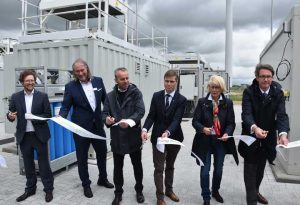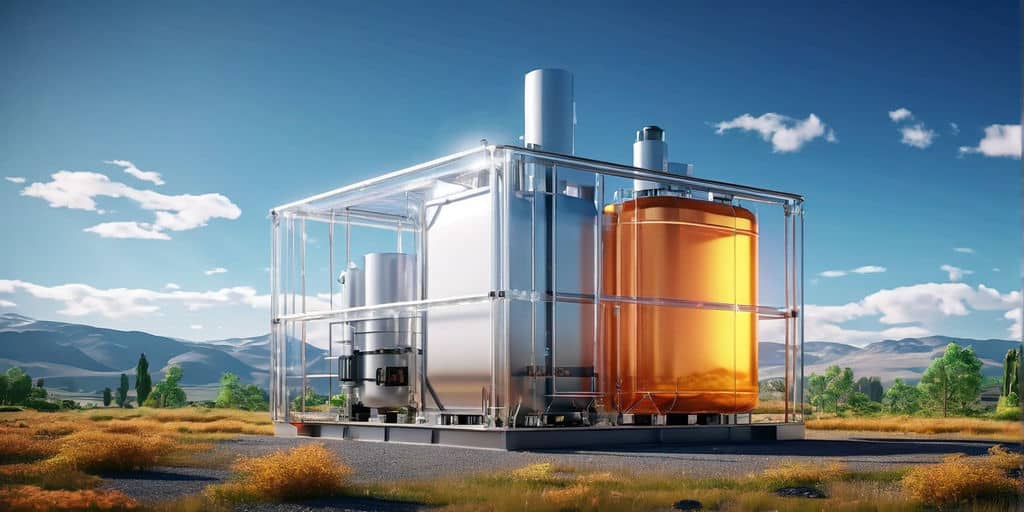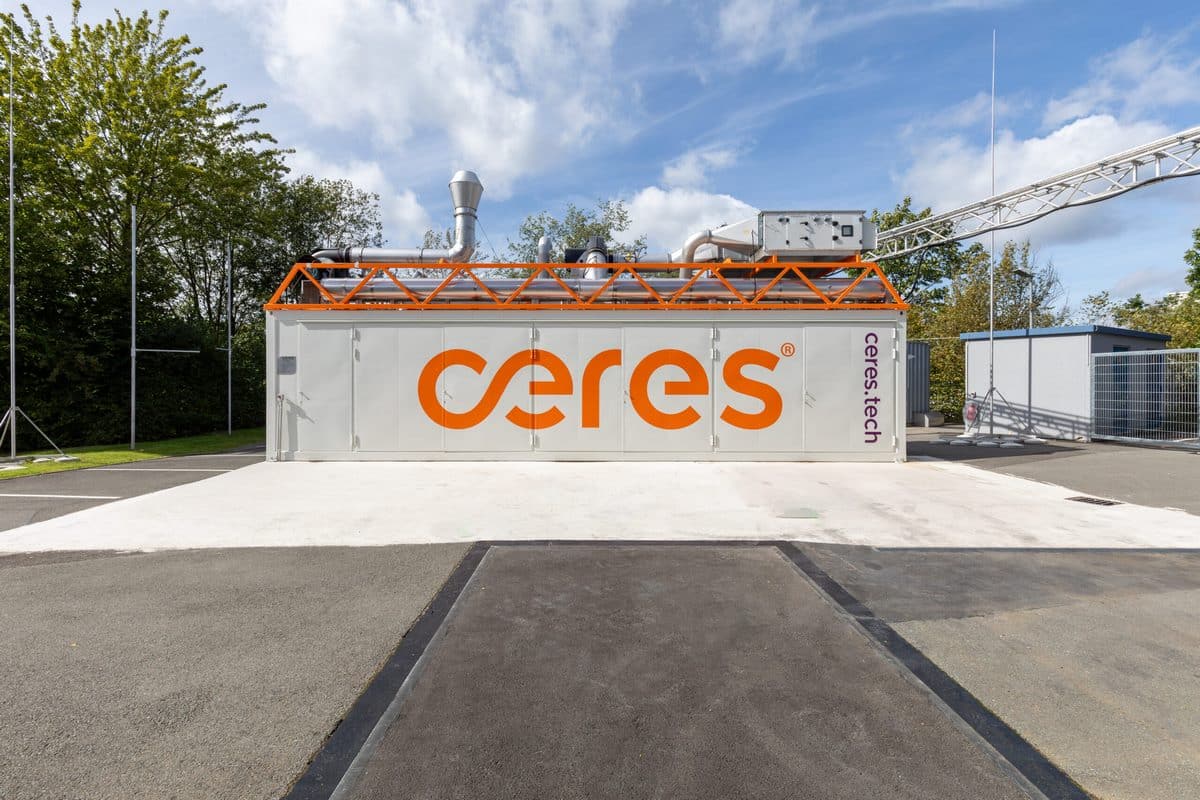
To get eFarm underway, German transportation minister Andreas Scheuer and many of the project’s partners came to Bosbüll on July 7 despite dreary weather. “Germany’s largest hydrogen transportation project,” as GP Joule calls it, involves building two fueling stations, two fuel cell buses, seven tanks to deliver gas by truck, and five 225-kilowatt electrolyzers, each of which will be put up at a different site.
It was a gray and stormy day, typical of northern Germany. But that did little to dampen the mood among attendees as the prominent guests in their midst cut the ribbon on the eFarm project (see fig. 1). Surrounded by wind turbines, German transportation minister Andreas Scheuer said that “this project is the perfect example of how to implement Germany’s hydrogen strategy, from using wind energy for clean energy generation to broadly expanding the needed infrastructure. This is how we will get clean, eco-friendly transportation. […] Some say we will do this with a bang; I say it is going to be a German turbo.”
EUR 16 million will be poured into the project, covering half of its costs. Hopes are that the venture will become a beacon for all of Germany and show how excess wind energy can be used in zero-emission transportation while creating trust among those unsure of whether wind turbines and hydrogen power plants are a good idea.
Farmer turned hydrogen producer
The developer’s name is John-Heinrich “Jonny” Ingwersen, the chief executive of eFarming. Until 2018, his firm was known as GPJ Energiepark 103, set up in 2017 (see H2-international, January 2019). Ingwersen, a farmer by trade, was and still is the manager of several community wind and solar farms in Bosbüll. Throughout the region, he is seen as a pioneer, considering his first ventures into the renewable energy sector date to 1993. He told H2-international that the current project “is something we are pretty proud of.”
Among GP Joule’s partners are several wind farm operators. They hope that the project will allow them to keep on the turbines that will soon drop out of Germany‘s clean energy incentive program. There has been enormous interest in the new technology, with over a hundred people having stated their intention to buy an FCEV.
The production capacity of the H-Tec ME 100/350 PEM electrolyzer that will be run in Bosbüll is 100 kilograms of hydrogen a day. The waste energy generated by the system will be used to heat nearby buildings, which will raise efficiency to more than 95 percent. The hydrogen produced this way will be transported to two fueling stations, one in Niebüll and another in Husum. Their completion, originally scheduled for the second quarter, has been postponed. The two fuel cell buses will also be delivered later than expected, presumably in September.

























Generating hydrogen from water using electricity costs half the energy that is put into it. Then the stuff is compressed, because hydrogen is a gas at our temperatures, and in order to accommodate usable amounts of it in a car, you have to compress it, e.g. to 700 bar pressure. So for 700 bar you need a very stable container – but that’s another story.
In any case, from pumping bicycle tires we know that compression costs energy. At 700 bar that’s a lot. In addition, at this pressure the hydrogen with its tiny molecules will do everything possible to escape from its container. In the process, we lose around a fifth of the energy that was originally present in hydrogen by the time the stuff is in the car.
There the hydrogen is converted into electricity in fuel cells, with an efficiency of at best 50%. How much then ultimately gets into the car’s engine?
Here is the calculation: 1/2 x 4/5 x 1/2 = 1/5 = 20%, that’s what remains.
Of 100 kilowatt hours that came from the windmill, only around 20 kWh end up finally in the motor. Or vice versa, for every kWh that is consumed by the car, the mill would have to produce five times as much energy.
We drivers do not calculate in kilowatt hours, but in gasoline, and a liter does around 3.5 kWh of mechanical work (a total of three times the energy is in it, but two thirds are inevitably lost as heat.)
Let’s assume you drive 15,000 km a year and need 8 liters per 100 km. Then you fill up with 1,200 liters a year. This amount of gasoline gives you 1,200 x 3.5 kWh = 4,200 kWh. If you wanted to get this energy from hydrogen, how much would the windmill have to produce for it? Because of the losses described: five times as much, namely 4,200 kWh x 5 = 21,000 kWh.
Such a decent windmill has a nominal output of 1,000 kilowatts. But it only generates this when the weather gods step on the accelerator. On average, it produces significantly less, let’s say 300 kW. We multiply that by the number of hours per year and lo and behold: On average, our mill delivers 2,628,000 kWh annually, i.e. two to three million kWh.
If everyone drives like you now, then one mill could supply 2,628,000 kWh / 21,000 kWh = 125 drivers. And with 40 million car drivers in the country, you would need 40,000,000 / 125 = 320,000 windmills of this type. Is that a lot?
That would be around ten times the current level. The stubborn population might not take part anymore, they are already complaining. So you would first have to abolish the population, then you would finally have a free hand and totally green cars.
Leider habe ich vergessen, meine Quelle für meinen obigen Beitrag anzugeben. Der Originaltext ist in deutscher Sprache abgefasst und unter folgendem Link erschienen. https://www.achgut.com/autor/hofmann-reinecke_h
Generating hydrogen from water using electricity costs half the energy that is put into it. Then the stuff is compressed because hydrogen is a gas at our temperatures, and to accommodate usable amounts of it in a car, and you have to squeeze it, e.g., to 700 bar pressure. So for 700 bar, you need a very sturdy container – but that’s another story.
In any case, we know that compression costs energy at 700 bar; that’s a lot. Besides, the hydrogen with its tiny molecules will do everything possible to escape from its container at this pressure. In the process, we lose around a fifth of the energy initially present in hydrogen when the stuff is in the car.
The hydrogen is converted into electricity in fuel cells, with an efficiency of at best 50%. How much then ultimately gets into the car’s engine?
Here is the calculation: 1/2 x 4/5 x 1/2 = 1/5 = 20%, that’s what remains.
Of 100 kilowatt-hours from the windmill, only around 20 kWh finally ended up in the motor. Or vice versa, for every kWh consumed by the car, the mill would have to produce five times as much energy.
We drivers do not calculate in kilowatt-hours, but gasoline and a liter do around 3.5 kWh of mechanical work (a total of three times the energy is in it, but two-thirds are inevitably lost as heat.)
Let’s assume you drive 15,000 km a year and need 8 liters per 100 km. Then you fill up with 1,200 liters a year. This amount of gasoline gives you 1,200 x 3.5 kWh = 4,200 kWh. If you wanted to get this energy from hydrogen, how much would the windmill have to produce for it? The losses described are five times as much, namely 4,200 kWh x 5 = 21,000 kWh.
Such a decent windmill has a nominal output of 1,000 kilowatts. But it only generates this when the weather gods step on the accelerator. On average, it produces significantly less, let’s say 300 kW. We multiply that by the number of hours per year, and lo and behold: On average, our mill delivers 2,628,000 kWh annually, i.e., two to three million kWh.
If everyone drives like you now, then one mill could supply 2,628,000 kWh / 21,000 kWh = 125 drivers. And with 40 million car drivers in the country, you would need 40,000,000 / 125 = 320,000 windmills of this type. Is that a lot?
That would be around ten times the current level. The stubborn population might not take part anymore; they are already complaining. So you would first have to abolish the people, then you would finally have a free hand and green cars.
The original text is written in German and can be found at the following link. https://www.achgut.com/autor/hofmann-reinecke_h
Translation by Olaf Borkner-Delcarlo
Dabei hat Herr Dr. Hans Hofmann-Reinecke nur mal die Anzahl der benötigten Windkraftanlagen allein für die Elektromobilität in D berechnet. Also wenn man die Anzahl der aktuell betriebenen Windmühlen verzehnfacht, dann hat man gerade mal den Strom für die Elektroautos und noch keine einzige kWh für den sonstigen Stromverbrauch in unserem Land! Ist das nicht witzig?!
Scheuer? Ist das nicht der Typ, der die 600 Mill. In den Sand gesetzt hat? Und der ist in Deutschland immer noch Minister?